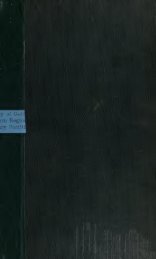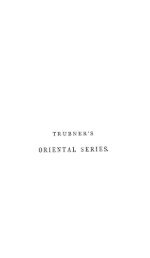Untitled
Untitled
Untitled
Create successful ePaper yourself
Turn your PDF publications into a flip-book with our unique Google optimized e-Paper software.
'<br />
140<br />
k NOTES ON THE FOURTH DISCOURSE<br />
<<br />
holds good of much Persian rpoetry. Thirdly, their gentle melancholy,<br />
half sceptical mysticism arid graceful pessimism are congenial to an age<br />
which, like his own, has come to the conclusion tr/at science can answer<br />
almost every question save that -which most intimately concerns our own<br />
hopes and happiness.<br />
The inforiration given by Mirza Muharrftnkd in the latter part of his ,<br />
. note. (pp. 222-7) about the European renderings of 'Umar-i-Khayyam<br />
and his admirers and imitators, and especially about the Club called by ,<br />
his name, though new to most Persian readers, is familiar to all in this<br />
country who take an interest in such matters, and may be found in great<br />
detail in t Nathan Haskell Dole's " Multi-Variorum edition" (Macmillan,<br />
London, 1898).<br />
'<br />
'<br />
(<br />
<<br />
Note XXVI. On certain medical terms in the Preface<br />
to the Fourth Discourse.<br />
(Text, pp. 68-9 ;<br />
Persian notes, p. 230.)<br />
The Pulse (Naod) is very fully discussed in all Arabic and Persiaa<br />
works on Medicine, e.g. the Firdawsu'l-Hikmat of 'All ibn Rabbali<br />
at-Tabari, Naw^ iv, Maqdla xii, chs. 6-9 (Brit. Mus. Arundel Or. 41,<br />
ffl i63 a<br />
-i6s b ); the Kamilu's-Sina'at, also called al-Kitabu'l-<br />
Maliki, of 'Ali ibnu'l-'Abbas al-Majusf, Part I, Maqdla vt'i, chs. 2-11<br />
(Cairo ed. of 1294/1877, vol. i, pp. 254-281); the Qanun of Avicenna,<br />
Book I, Fann ii, TffUm iii,Jumla 1(19 sections), pp. 62-8 of the Rome<br />
edition of A.D. 1593<br />
= b b<br />
ff.<br />
( 49 ~53 of the Latin translation printed at<br />
Venice in 1544); and [he Persian Dhakhira-i-Khwarazmsha'hi,<br />
Book 12', Guftdr Hi, chs. 1-23.<br />
As our author chiefly follows Avicenna, we-may conveniently do the<br />
same, though indeed the general views of all these writers appear to be<br />
almost identical. Each pulsation consists of four factors or elements,<br />
two movements (harakaf), a diastole (inbisdt} and a systole (inqibdd),<br />
and two pauses (suktiri) separating the two movements. The ten kinds or<br />
genera (jins) of pulse are determined by consideration of the following<br />
features :<br />
t t , (i) The amount of the diastole (miqddru*l-tnbif it," genus quod* est<br />
sumptum ex quantitate diastoles "). In this genus th/ee elements'" are to<br />
be considered, length (tul), breadth l<br />
( ard} 'and l<br />
depth ( um%),<br />
each of<br />
which supplies three simple varieties of pulse, two extremes and a mean,<br />
besides composite varieties, which I shall not here enumerate* Thus we<br />
have the long (tawil}, the short (qasir, "curtus") a.nd the intermediate,<br />
the broad ('arid, "latus"), the narrow (dayyiq,<br />
(mu'tadil, " mediocris ") ;<br />
" "<br />
strictus ") and the intermediate the ; depressed (mukhaffad, pro-<br />
fundus "), the ascending, elevated or prominent (mushrif, " apertus ")<br />
and the intermediate.<br />
(2) The quality of the impact on the fingers of the observer<br />
(kayfiyyatu qar'i'l-harakati'l-asdbi'a, "genus quod est sumptum ex<br />
qualitate percussionis venae in digitos "). This also has three varieties,<br />
the strong (qawi, "fords"), the weak (da 1<br />
!/, "debilis") and the intermediate<br />
(mufadil, " asqualis ").








![La religione di Zarathustra nella storia religiosa dell' Iran [microform]..](https://img.yumpu.com/15970820/1/151x260/la-religione-di-zarathustra-nella-storia-religiosa-dell-iran-microform.jpg?quality=85)


